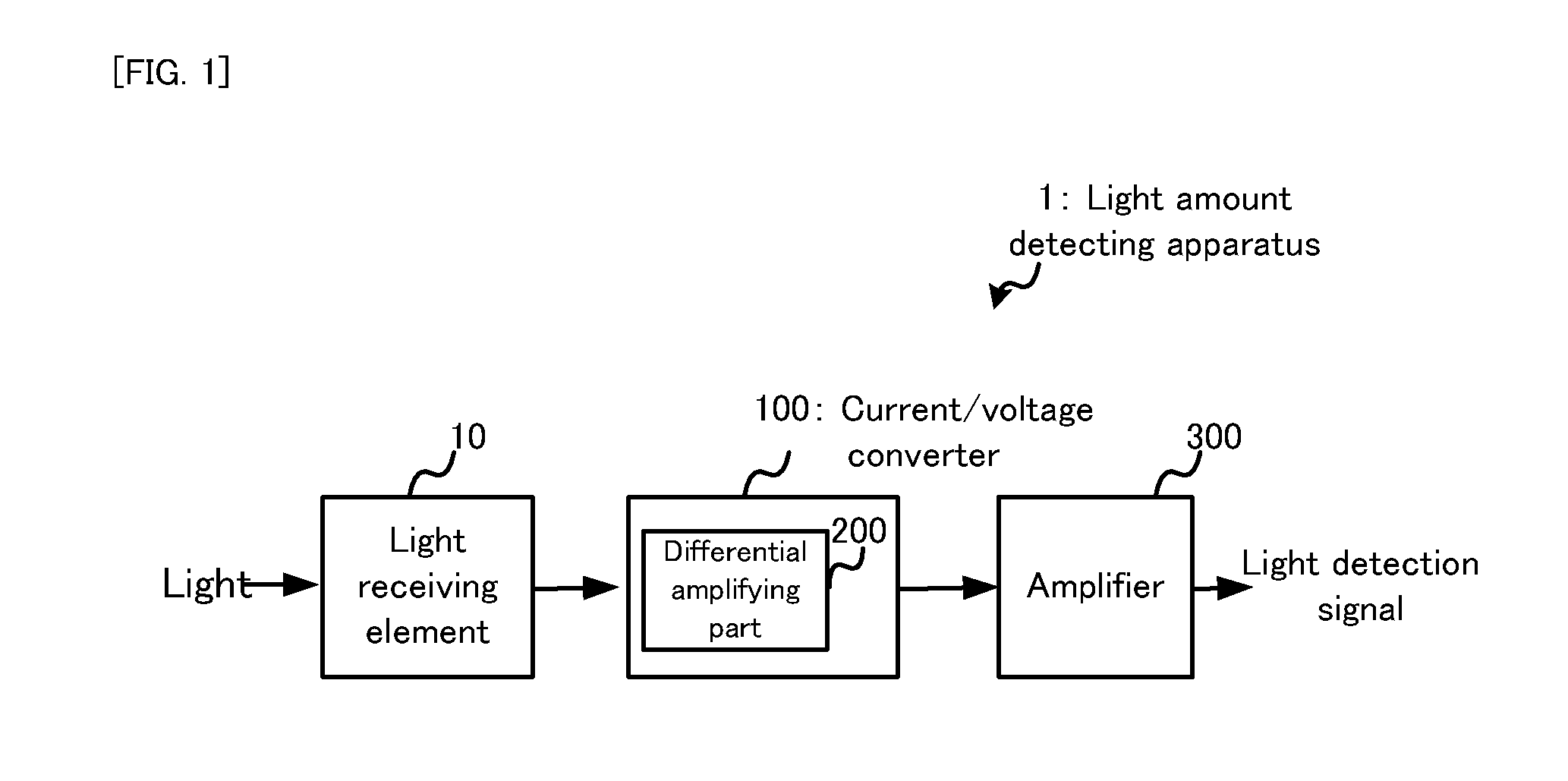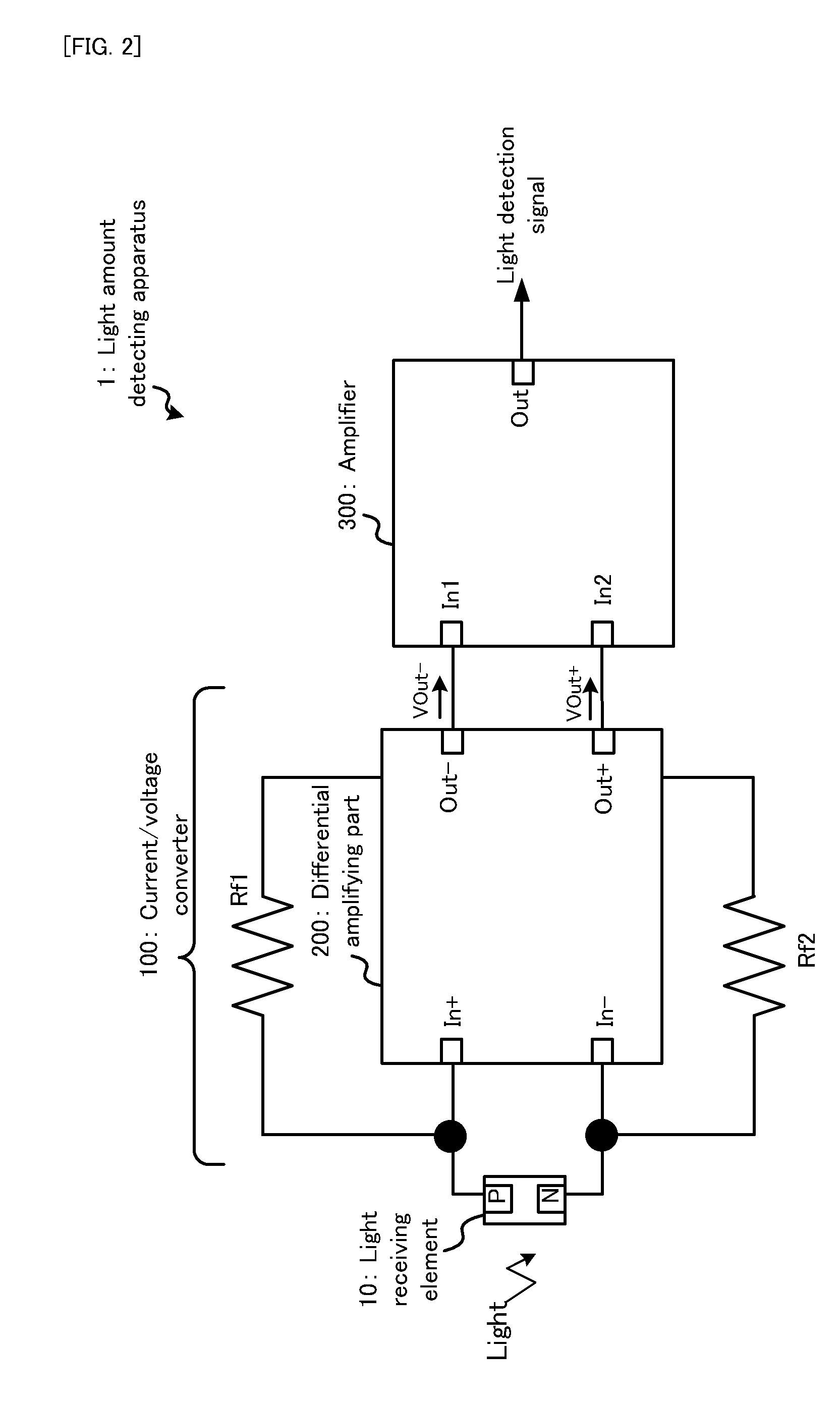Light amount detecting apparatus, and light amount information processing apparatus
- Summary
- Abstract
- Description
- Claims
- Application Information
AI Technical Summary
Benefits of technology
Problems solved by technology
Method used
Image
Examples
first embodiment
[0057]
[0058]Firstly, with reference to FIG. 1 and FIG. 2, the basic configuration of a first embodiment of the present invention will be explained. FIG. 1 is a block diagram conceptually showing the entire structure of a light amount detecting apparatus 1 in a first embodiment. FIG. 2 is a block diagram schematically showing the detailed structure of the light amount detecting apparatus 1 in the first embodiment.
[0059]As shown in FIG. 1 and FIG. 2, the light amount detecting apparatus 1 in the first embodiment is provided with a light receiving element 10, a current / voltage converter 100 including a differential amplifying part 200, and an amplifier 300. The current / voltage converter 100 is provided with the differential amplifying part 200 and feedback resistors Rf1 and Rf2. The amplifier 300 is provided with input terminal In1 and In2 and an output terminal Out.
[0060]The light receiving element 10 receives a small amount of light inputted from the exterior and outputs a detection ...
second embodiment
[0107]Next, the detailed structure of an amplifier 300a in a second embodiment will be explained. FIG. 6 is a circuit diagram schematically showing the detailed structure of the amplifier 300a in the second embodiment. Incidentally, in the amplifier 300a in the second embodiment, substantially the same constituents as those of the amplifier 300 in the first embodiment described above will carry the same reference numerals, and the explanation thereof will be omitted, as occasion demands. Moreover, since a light receiving element 10 and a current / voltage converter 100 in the second embodiment are substantially the same as the light receiving element 10 and the current / voltage converter 100 in the first embodiment, their explanation will be limited for convenience sake.
[0108]As shown in FIG. 6, the amplifier 300a in the second embodiment is provided with operational amplifiers OP1 and OP2, feedback resistors R2 and R3, a common input resistor R1, low pass filters (i.e. low-fr...
third embodiment
[0111]Next, with reference to FIG. 7 to FIG. 10, a light amount detecting apparatus 1 in a third embodiment will be explained. Incidentally, regarding the constituents in the third embodiment, the constituents which are substantially the same as those in the first and second embodiments described above will carry the same reference numerals, and the explanation thereof will be omitted as occasion demands.
[0112]
[0113]Firstly, with reference to FIG. 7 and FIG. 9, the detailed structure of a current / voltage converter 100b in the third embodiment and modulation on the current / voltage converter 100b will be explained. FIG. 7 is a block diagram schematically showing the detailed structure of the current / voltage converter 100b in the third embodiment. FIG. 9 is waveform diagrams along a time axis showing a detection current Idt of a light receiving element, detection voltages Vout+ and Vout−, control signals of a switch action SWP1, SWP2, and SWP3, and a light detection signal DtOut in the...
PUM
 Login to View More
Login to View More Abstract
Description
Claims
Application Information
 Login to View More
Login to View More - R&D
- Intellectual Property
- Life Sciences
- Materials
- Tech Scout
- Unparalleled Data Quality
- Higher Quality Content
- 60% Fewer Hallucinations
Browse by: Latest US Patents, China's latest patents, Technical Efficacy Thesaurus, Application Domain, Technology Topic, Popular Technical Reports.
© 2025 PatSnap. All rights reserved.Legal|Privacy policy|Modern Slavery Act Transparency Statement|Sitemap|About US| Contact US: help@patsnap.com



